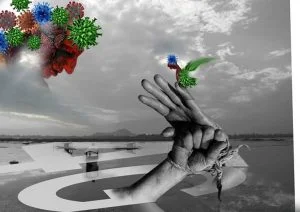
Ayswarya Murthy
Srinagar: Masood Hussain’s last known work, the 2016 series ‘Silent Images’, depicted the damage done by pellet guns to the children of the valley, a departure of his usual style, with the use of dark tones in a digital medium. He has continued that tradition in the latest multi-media artwork he released on Friday. There is no time for subtext and the message is obvious, literally written all over it. The virus has arrived at Kashmir’s door and, without effective communication, its people are helpless to fight it.
Hussain was in Delhi when he first started hearing about the virus and the precautions that needed to be taken. When he returned to the city last week, he found there wasn’t much of a facility set up at the airport to check for the virus. “We were accompanied by so many people coming in from the Middle East and all we were asked to do was fill up a form,” he says. He worries that the situation in Kashmir is not being monitored properly, and there may be many people in the Valley already carrying the virus.
The first positive case in Kashmir was reported on March 18 from the old city Khanyar area of Srinagar; a 67-year-old woman with a history of foreign travel. By Friday, the number of suspects under surveillance in J&K reached 3300. Neighbouring Ladakh is badly hit with ten positive cases. As the infection looms for Kashmir, their biggest challenge at hand is the information vacuum. “We need to be connected to the world,” Hussain says.
The partial Internet shutdown in place in Kashmir since August last year has restricted connectivity to 2G and despite the coronavirus scare in the Valley, the government extended the ban on high-speed internet until March 26. Rather than provide free access to information during these times, the government has instead strengthened the physical blockade in the valley with Section 144 imposed in Srinagar and other major towns since the first case was reported. Razor wire barricades and armoured trucks have been put in place to keep the movement of people and vehicles under check for the third day in a row even as markets, educational institutions, parks and restaurants are shut.
It has been proven, and is common sense, that people who understand the seriousness of the pandemic would be more willing to cooperate with self-quarantine and the reporting of symptoms. This can only be effectively communicated through the internet. The Kashmiri diaspora around the world has written to WHO to ask Indian government to immediately reinstate 4G services in the Kashmir Valley in light of the COVID-19 pandemic. Hussain is hoping for the same. “The government must restore 4G. The current 2G connections are slow and now that people are expected to stay indoors and work, faster connections are very important.”
Set against the Dal Lake, his latest work sends out the same message. “The virus has arrived. We need to take precautions and we need information, and for that we need Internet.”
Follow this link to join our WhatsApp group: Join Now
Be Part of Quality Journalism |
Quality journalism takes a lot of time, money and hard work to produce and despite all the hardships we still do it. Our reporters and editors are working overtime in Kashmir and beyond to cover what you care about, break big stories, and expose injustices that can change lives. Today more people are reading Kashmir Observer than ever, but only a handful are paying while advertising revenues are falling fast. |
| ACT NOW |
| MONTHLY | Rs 100 | |
| YEARLY | Rs 1000 | |
| LIFETIME | Rs 10000 | |











